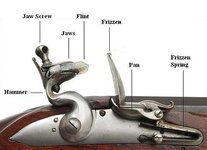Minrelica
Bronze Member
Well after about 3 years of running into a certain acquaintance that I see at a local watering hole every once in a while and talk treasure hunting with, he finally agreed to take me to his spot where he claimed to find musket balls, many just on top of the soil in a wooded area. He agreed only after I informed him that I had a metal detector he could use if he took me there. Once we arrived I realized that I've hunted about 100 yards from that very spot but only found a few coins. Once we started hunting it didn't take long for me to find my first "ball"... I ended up with 4 full ones and 2-3 smashed ones that are not pictured due to me misplacing them... I also found a shell casing stamped F A 7 02. The balls all weigh 25g and I included both a penny and caliper reading for size reference.



After about 30 minutes of hunting with my friend I noticed he was talking with someone... It turns out that his buddy had been hunting that area for some time and was really protective over it so when he heard that I was being shown the same spot, he showed up to meet me and see what I was all about... Well, 5 minutes after meeting him he invited me over to his car where he pulled out a shoe box of some of his finds from that area over the past couple of years.



There were many more items but these are 3 that I told him I would post for him to find out exactly what they are... Unfortunately this person passed away less than a week after I met him so I won't be able to pass along the information but I would really like to know...
Are these musket balls?
Is the pin possibly a 10th infantry band leaders pin?
Are these flints?
I know virtually nothing about any of these subjects so any input would me much appreciated.



After about 30 minutes of hunting with my friend I noticed he was talking with someone... It turns out that his buddy had been hunting that area for some time and was really protective over it so when he heard that I was being shown the same spot, he showed up to meet me and see what I was all about... Well, 5 minutes after meeting him he invited me over to his car where he pulled out a shoe box of some of his finds from that area over the past couple of years.



There were many more items but these are 3 that I told him I would post for him to find out exactly what they are... Unfortunately this person passed away less than a week after I met him so I won't be able to pass along the information but I would really like to know...
Are these musket balls?
Is the pin possibly a 10th infantry band leaders pin?
Are these flints?
I know virtually nothing about any of these subjects so any input would me much appreciated.
Last edited:








